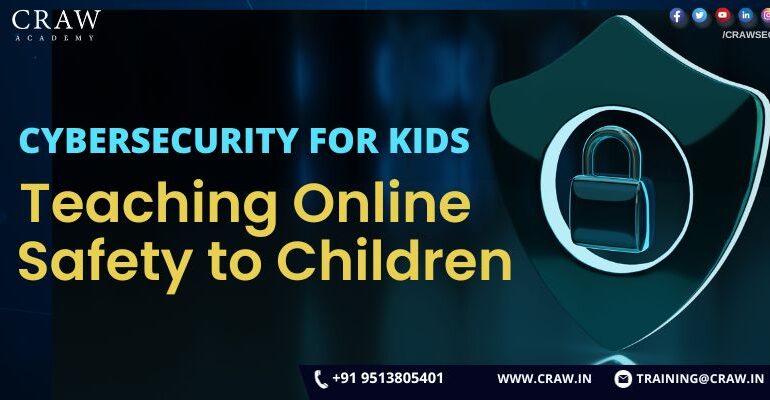Cybersecurity for Kids Teaching Online Safety to Children

Cybersecurity for Kids Teaching Online Safety to Children
Cybersecurity for Kids: Teaching Online Safety to Children
The Internet offers a multitude of opportunities for educational pursuits, e-commerce, recreational activities, and social interactions. Regrettably, the internet environment is also inhabited by individuals with malicious intent, such as predators and identity thieves, who pose a threat to one’s well-being. To ensure online safety, it is imperative for anyone, including both adults and children, to possess a comprehensive understanding of the potential hazards associated with internet usage.
Numerous children possess a sense of assurance over their ability to navigate the digital realm in a secure manner. Nevertheless, there exist certain factors that contribute to the heightened vulnerability of children. Individuals may not consistently consider the potential ramifications of their acts, leading to an inclination to provide excessive personal information. Children are occasionally singled out by cyberbullies or individuals with malicious intent.
If an individual assumes the role of a parent or guardian, they possess the ability to contribute to the safety of their children by engaging in discussions on their Internet usage, imparting knowledge about potential hazards online, and acquiring a comprehensive understanding of the Internet to facilitate informed decision-making.
In this article, we will try to elaborate on the mainstream factors that can shed some light on implementing rightful methods of cybersecurity for kids.
Internet Safety for Students
The importance of internet safety for students cannot be overstated, given their growing dependence on online resources for educational, communicative, and recreational purposes. Presented below is an all-encompassing compendium elucidating the principles and practices of online safety specifically tailored for students.
- Personal Information Protection
| Never Share Personal Information | It is imperative to provide students with instruction regarding the need to refrain from disclosing personal information, such as complete names, residential addresses, contact numbers, or educational institution names, on public online platforms or social media networks. |
| Strong Passwords | It is highly recommended to promote the utilization of robust and distinct passwords for every individual account. It is recommended that passwords incorporate a combination of alphabetic characters, including both uppercase and lowercase letters, numerical digits, and special symbols. |
| Regularly Update Passwords | Regularly changing passwords and employing unique passwords for each and every website will effectively mitigate susceptibility. |
- Awareness of Online Predators
- Stranger Danger: Similar to the offline realm, it is imperative for students to exercise prudence when interacting with unfamiliar individuals in the internet domain.
- Private Chats: It is advisable for students to use caution while engaging in private conversations with those whom they are unfamiliar with. The utilization of this strategy is frequently observed among those engaging in predatory behavior on the internet.
- Recognizing Scams and Phishing
| Too Good To Be True | It is imperative to instill in students a sense of skepticism against offers or information that appear too advantageous and maybe unrealistic. |
| Check URLs | To confirm the legitimacy of websites, it is advisable to hover over links before clicking on them. It is advisable to exercise caution and remain vigilant for domains with misspelled words or extensions that are suspicious in nature. |
| Avoid Downloading from Untrusted Sources | The act of downloading data from sources that are not well-known or recognized can potentially expose computer systems to the risk of virus infiltration. |
- Social Media Awareness
- Privacy Settings: It is imperative for students to possess knowledge regarding the privacy options offered by the platforms they utilize, and they should be actively encouraged to configure their profiles in a private setting.
- Think Before Posting: Highlight the enduring characteristics of the internet over an extended period. Once a piece of content is published, it can provide challenges in terms of total removal.
- Cyberbullying Awareness and Prevention
| Speak Up | It is imperative to foster a culture that promotes the reporting of any instances of bullying that students may observe or encounter. |
| Document Evidence | It is advisable to preserve visual records, such as screenshots or communications, as potential evidentiary material in case they are required for future reference or verification. |
| Block and Report | Utilize platform features to employ measures such as blocking or reporting individuals engaging in bullying behavior. |
- Safe Browsing Habits
| Use Reputable Sources | In the context of academic endeavors, it is imperative for students to place their reliance on websites that are deemed trustworthy. |
| Enable Safe Search | Utilize software applications designed to effectively screen and eliminate inappropriate content. |
| Regularly Update and Use Security Software | It is imperative to ensure that devices are equipped with up-to-date security software, firewalls, and antivirus programs. |
- Educate About Digital Footprint
- Everything Leaves a Trace: One’s digital footprint can be influenced by every website visited, photo uploaded, or comment made.
- Potential Consequences: It is not uncommon for employers, educational institutions, and other entities to conduct online searches to gather information on individuals. It is imperative to ensure that one’s self-presentation is characterized by good attributes.
- Limit Screen Time
Balanced Life: Excessive internet usage can have detrimental effects on one’s physical well-being, sleep patterns, and interpersonal abilities. It is advisable to promote the incorporation of regular intervals and engagement in activities that do not include the use of electronic devices.
- Awareness of Fake News
- Cross-check Information: Prior to accepting or disseminating knowledge, it is imperative that students are instructed in the practice of corroborating it through the consultation of various reliable sources.
- Question Sources: It is imperative to ascertain the origin and authenticity of the information.
- Keep Communication Open
Encourage Dialogue: It is imperative for students to cultivate a sense of ease while engaging in conversations regarding their internet experiences, apprehensions, and uncertainties with reliable adults or instructors.
- Stay Updated
The digital environment is undergoing rapid evolution. It is imperative to consistently assess and revise safety protocols.
Importance of Online Safety for Students
In our day-to-day digital advancements of the current world, students extensively depend on the internet as a primary resource for academic inquiry, communication, and recreational activities. In the context of traversing the expansive digital realm, it is imperative to emphasize the need to ensure online safety. The internet provides a plethora of information and possibilities, yet it also poses several risks, encompassing cyberbullying, online predators, fraudulent activities, and exposure to unsuitable material.
In the absence of sufficient precautions and understanding, it is possible for students to inadvertently jeopardize their personal information, damage their digital presence, or experience emotional distress as a result of unscrupulous actors. The prioritization of online safety is of utmost importance, as it serves the dual purpose of safeguarding students from immediate dangers and cultivating responsible digital behaviors that will have long-term advantages for their well-being.
Online Safety Awareness for Kids
To ensure the safety of your children, it is imperative to acquire knowledge regarding the various categories of online hazards that are prevalent. Children and adolescents may encounter inappropriate material on the Internet, including explicit content such as pornography or offensive language.
Additionally, there exists the potential for individuals to engage in cyberbullying or cyber harassment within the online realm. However, it should be noted that the aforementioned hazards may not necessarily be encountered by your child. Moreover, acquiring knowledge of the potential hazards can enable both you and your children to make informed choices while navigating the digital realm.
Teaching Kids About Online Safety
The act of navigating the digital domain might be likened to traveling to a sprawling and complex metropolis characterized by an abundance of educational and social prospects yet concealing latent perils. In a manner analogous to instructing youngsters on navigating streets and engaging with unfamiliar individuals in the offline realm, it is imperative to provide them with education on the subject of online safety.
In addition, educating children on safe internet usage entails imparting knowledge regarding the various hazards associated with it, ranging from divulging excessive personal information to encountering instances of cyberbullying. By providing knowledge on the need to identify reliable sources, detecting phishing attacks, and establishing robust passwords, we equip individuals with the necessary resources to safeguard their personal information.
In addition to providing basic security measures, this form of education cultivates a cohort of digitally literate individuals who engage with the online realm with a combination of inquisitiveness and prudence.
Online Dangers for Kids
It is imperative for children to exercise caution while accessing the Internet, as potential risks extend beyond the realm of inappropriate websites. Engaging in chat rooms, computer games, and social networking sites can entail certain risks. If children possess mobile devices, it is imperative for them to exercise caution while engaging in texting or utilizing internet services on those devices.
Texting
- Instant messaging & chat rooms: It is highly likely that a cyberbully or a cybercriminal might reach your kids via these soft corners. We can train our kids that if someone is harassing you, you can always block that person.
- Computer Games: Many computers as well as mobile games, have a built-in chat feature that lets users chat with one another while playing the game. It is also possible that some anti-social elements could reach your kids via this.
- Mobile Phones’ Inbox: In this world where we want to keep a tap on our children at every passing minute, we usually provide smartphones and gadgets to our kids by which they can be exposed to cyberbullying via text messages through SMSs or trapped to some other concerns.
- Emails: Emails are widely used, and it is a very popular form of communication as well as a tool for many different types of scams. Online predators or cyberbullies use this method widely.
Software Downloads
Many email attachments carry harmful messages as well as malware that can be downloaded in the disguise of useful information or software.
Social Networks
- Many social networking sites, like Facebook, Instagram, Snapchat, etc., give you a vast space to enter into the virtual world by sharing your utmost crucial and sensitive types of information. We need to train our kids against sharing any such material on social networking sites to avoid any blackmail or cyberbullying in the near future.
- Moreover, some social networking sites like FarmVille may reveal your profile information to other companies for profit.
File Sharing Networks
- In file-sharing networks, also known as peer-to-peer networks or P2P, many files contain malware or viruses.
- You can also get into legal trouble if you download or share any copyrighted media onto sites like YouTube.
Cybersecurity Games for Kids: Learning Online Safety
Sure! Engaging in cybersecurity games can serve as an enjoyable and interactive method for children to acquire knowledge pertaining to the realm of internet safety. The incorporation of play into the learning process frequently results in enhanced retention and comprehension. Presented below is a compilation of gaming concepts that revolve around the domains of cybersecurity and internet safety:
| Game Name | Concept |
| Password Puzzle Quest | Children go through a virtual realm, gaining access to various areas by employing robust passwords. Every tier of the game instructs participants on the principles of generating and retaining robust passwords, employing a combination of letters, numerals, and symbols. |
| Phishing Frenzy | Children navigate a simulated aquatic environment aboard a vessel, whereby their objective is to apprehend desirable piscine specimens symbolizing authentic electronic correspondences, while simultaneously evading undesirable specimens representing deceitful phishing communications. The primary focus lies in the recognition of suspicious email characteristics, such as instances of misspellings or anomalous email addresses. |
| Firewall Fortress | Participants construct and uphold a fortified structure, symbolizing a computational system, while safeguarding it against imminent perils, such as viruses and malware. Players get knowledge on the need to regularly upgrade and effectively manage security software. |
| Info Guard Guardians | The proposed game involves players assuming the role of guardians responsible for safeguarding an information tower situated within a city. It is imperative to guarantee that access is granted exclusively to authorized characters. This emphasizes the significance of refraining from disclosing personal information on the internet. |
| Escape from Cyberbully Central | The objective of the game is for players to successfully navigate through a maze while actively avoiding instances of cyberbullying. Additionally, players are required to acquire various tools that can be utilized to effectively block and report cyberbullies. This serves to strengthen the recommended course of action for children who come across instances of internet bullying. |
| Secure Surfing Safari | Children engage in online activities by navigating through a virtual platform, utilizing a digital interface resembling a board, with the objective of evading potential threats such as “malware monsters” and “phishing pits.” Simultaneously, they strive to accumulate safety badges as a means of enhancing their online security. This educational program imparts knowledge on practicing secure surfing behaviors and acquiring the ability to identify and evade potential online risks. |
| Digital Detective | The participants in this game undertake the role of investigators, engaging in the examination of various online scenarios with the objective of ascertaining their level of safety or dubiousness. The researchers will examine many sources, including social media posts and app download pages, among others. |
| Crypto Coin Collector | The proposed game entails children engaging in the collection of virtual currencies within a digital environment, employing encryption mechanisms to safeguard their acquired assets. The text provides an introduction to the notion of encryption and its role in ensuring the security of information. |
| Safe Social City | Participants engage in the exploration of a simulated urban environment that serves as a metaphorical representation of social media. Within this context, they acquire knowledge pertaining to the establishment of privacy preferences, the identification of friend requests originating from unfamiliar individuals, and the comprehension of the enduring nature of online content. |
| Avatar Adventure | Children generate digital representations of themselves known as avatars, abstaining from the utilization of personal photographs. As individuals traverse through simulated environments, they acquire an understanding of the significance of maintaining anonymity and develop strategies to safeguard their digital persona. |
FAQs
About Cybersecurity for Kids
1: What is the best way to teach children about online safety?
The best way to teach children about online safety is to provide info to them via gamification.
2: How do you teach cybersecurity to children?
The pedagogical instruction of cybersecurity to children necessitates a methodology that is simultaneously captivating and tailored to their developmental stage. The primary objective is to render intricate concepts comprehensible and relevant. The following is a comprehensive instructional manual outlining the sequential process of imparting knowledge and skills pertaining to cybersecurity to young individuals:
- Start with Basics: What’s the Internet?,
- Personal Information and Privacy,
- Use Stories and Analogies,
- Interactive Activities,
- Games and Quizzes,
- Discussing Cyberbullying,
- Safe Browsing Habits,
- Introduce the Concept of a Digital Footprint,
- Hands-on Experience,
- Open Communication,
- Stay Updated,
- Model Good Behavior, etc.
3: What is the 5 cyber safety rules for kids?
Here are five fundamental cyber safety rules for kids:
- Guard Personal Information,
- Stranger Danger Online,
- Think Before You Click,
- Speak Up Against Cyberbullying,
- Maintain Digital Etiquette and Respect.
4: What are 3 ways for kids to stay safe online?
The 3 ways for kids to stay safe online are as follows:
- Use Parental Controls and Safe Search,
- Avoid Sharing Personal Information,
- Keep Communication Channels Open.
5: What is cyber safety for kids?
The concept of cyber safety for children encompasses the various strategies and precautions implemented to safeguard minors from potential dangers and vulnerabilities encountered while engaging with online platforms and technologies. The scope of this issue is extensive, covering various aspects such as safeguarding children’s personal data, preventing their exposure to improper content, and mitigating the risk of cyberbullying.
6: What is cyber security in simple words?
Cybersecurity refers to the systematic measures implemented to safeguard computers, servers, mobile devices, electronic systems, networks, and data against various forms of digital attacks, potential harm, or unwanted intrusion. Analogous to securing physical residences and possessions with locks and alarms, safeguarding our digital houses and goods from unauthorized access and malicious individuals is akin to employing protective measures.
7: Can a kid learn cyber security?
Absolutely! Children have the capacity to acquire knowledge and skills in the field of cybersecurity, which can prove advantageous for their development, particularly considering the pervasive influence of the digital age on their upbringing. The introduction of cybersecurity principles to children can effectively equip them with the necessary knowledge and skills to engage in secure online practices while also potentially fostering a keen interest in pursuing a profession within the cybersecurity domain. This article presents a recommended technique for facilitating cybersecurity education for children:
- Start Simple,
- Interactive Learning,
- Encourage Curiosity,
- Discuss Online Safety Regularly,
- Hands-On Projects,
- Join Clubs or Groups,
- Stay Updated,
- Advanced Learning, etc.
8: Why kids should learn cyber security?
Incorporating cybersecurity education into a child’s learning journey not only equips them with vital life skills for navigating the digital world but can also pave the way for a rewarding career in a rapidly growing field. Moreover, kids should learn cybersecurity for several important reasons:
- Early Exposure to Digital Environments,
- Protection from Threats,
- Prevention of Cyberbullying,
- Importance of Privacy,
- Future Career Opportunities,
- Building Responsible Digital Citizens,
- Foundation for Advanced Learning,
- Real-world Applications, etc.
9: What are safety rules for kids?
Safety guidelines for children encompass a broad spectrum of situations, spanning from routine daily activities to exceptional ones. Presented here is an exhaustive compilation of fundamental safety guidelines that hold significant importance in the context of children’s education:
- Personal Information,
- Be Cyber Secure,
- Stranger Danger,
- Buddy System,
- Safe Touch: Bad Touch, Good Touch,
- Emergency Contacts,
- Road Safety,
- Stay Put If Lost,
- Fire Safety,
- Water Safety,
- Online Safety,
- Bicycle Safety,
- Safe Play,
- No Drugs or Unknown Substances,
- Kitchen and Electrical Safety,
- Home Security,
- Respecting Animals, etc.
10: What is online safety in simple words?
Online safety refers to the practice of implementing measures to safeguard one’s personal information, privacy, and overall welfare from potential risks or detrimental consequences when engaging with the internet. Similar to using caution while navigating a bustling thoroughfare, individuals must also exercise prudence in the digital realm.
Conclusion
In the bottom line, we would comment that there are several methods that you can adopt to enhance Cybersecurity for Kids by Teaching Online Safety to Children with all proactive methods so that they can understand it widely and efficiently. Moreover, you may even seek the guidance of a well-professional cyber security expert to impart quality information to your kids having good excellence and expertise in the same vein, such as Craw Security, the Best Cybersecurity Training Institute in India, a valuable partner of the FutureSkills Prime, a MeitY — NASSCOM, Digital Skilling Initiative.
Learn 1 Year Diploma in Cyber Security Course by Craw Security or else do a quick 60-hour Ethical Hacking Course to understand the harmful effects of malicious hacking so precisely. Call +91-9513805401 for a demo session right away.
















